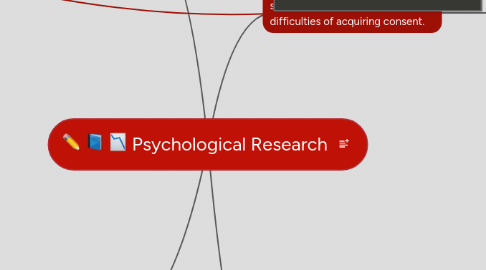
1. Research
1.1. How can I research my topic?
1.1.1. Internet/Research databases
1.1.1.1. Galileo
1.1.1.2. Peer Reviewed Journals
1.1.1.3. Media center web resources
1.1.2. School resources
1.1.2.1. AP Psychology teachers
1.1.2.1.1. Book on psychological experiments given to me by Mr. Domenico
1.1.2.2. Science research teachers
1.1.2.2.1. Human consent forms given to me by Ms. Sexton
1.1.3. Bibliography
1.1.3.1. Noodletools
1.1.4. Project facilitator
1.1.4.1. Mrs. Hall?
1.1.4.2. Contact someone from a local/semilocal university (student or professor?)
1.2. Research on humans
1.2.1. Human consent form used in science research course
1.2.2. Parental consent for those under 18
1.3. Product: Research paper
1.3.1. Follow paper guidelines for science research competition
1.3.2. Show research and background information
1.3.3. Show results and statistics
1.4. Focus on the application of your findings to the real world.
1.4.1. Business
2. Overcoming Cognitive Biases
2.1. Daniel Pink's Theory of Motivation
2.1.1. Extrinsic vs. Intrinsic Motivation
2.1.2. Businesses should model after psychology.
2.1.3. Do extrinsic motivators discourage creativity?
2.1.4. Daniel Pink's TED Talk: www.ted.com/talks/dan_pink_on_motivation
2.2. Carl Duncker's Candle Problem
2.2.1. Extrinsic motivators discouraged creativity.
2.2.2. Intrinsic motivation was more effective.
2.3. Wason's Number Problem
2.3.1. Illustrated confirmation bias
2.3.2. Showed prevalence of biases in cognition.
2.4. What are cognitive biases?
2.4.1. Cognitive biases are heuristics that obstruct thinking. To overcome them, humans must think creatively.
2.4.1.1. Psychologists create problems to test subjects' ability to overcome cognitive biases.
3. Experimentation
3.1. Use Wason's number problem.
3.1.1. Test for confirmation bias.
3.1.2. Recording results
3.1.2.1. If they are able to guess the number rule and do not show confirmation bias, they are counted as having overcome the bias.
3.1.2.1.1. Each subject is a different situation
3.1.2.1.2. A subject may guess the number rule but use confirmation bias. In that case, add them to their own group and mention them, but don't include them in the experimental statistics.
3.1.3. How many subjects?
3.1.3.1. Central limit theorem states that the sample is normally distributed with a sufficiently high sample size.
3.1.3.2. Two samples
3.1.3.3. About 40 subjects would be ideal
3.2. Factors to test?
3.2.1. Intrinsic v. Extrinsic motivation
3.2.1.1. Expand on Pink's and Duncker's ideas
3.2.1.2. Provide additional evidence with an alternate design.
3.2.1.3. How can I test this?
3.2.1.3.1. Candy/chocolate (extrinsic motivator)
3.2.1.3.2. List of those who got the problem correct (intrinsic motivator)
3.2.2. Age/gender
3.2.2.1. Are cognitive biases reinforced with experience?
3.2.2.2. Which gender thinks in a more creative, problem-solving fashion?
3.2.2.3. How can I test this?
3.2.2.3.1. Collect data from all participants
3.2.3. Presence of a limit on the number of guesses
3.2.3.1. Would this discourage confirmation bias?
3.2.3.2. How can I test this?
3.3. How can I interpret my results?
4. Statistical Analysis
4.1. Random allocation to experimental groups
4.2. Interpretation of results depends on experimental design
4.2.1. Two sample z test for proportions
4.2.1.1. Significant difference between the two groups, enough to where the variable can be said to have an effect on overcoming confirmation bias.
4.2.1.2. Significance level?
4.2.1.3. Conditions for a two sample z test of proportions
4.2.1.3.1. Both populations are greater than ten times the sample size.
4.2.1.3.2. Random allocation of subjects to treatments
4.2.1.3.3. Each trial is independent of all other trials.
4.2.1.3.4. Each sample includes at least five successes and five failures.
4.3. Resources on how to do statistical analysis
4.3.1. AP Statistics notes
